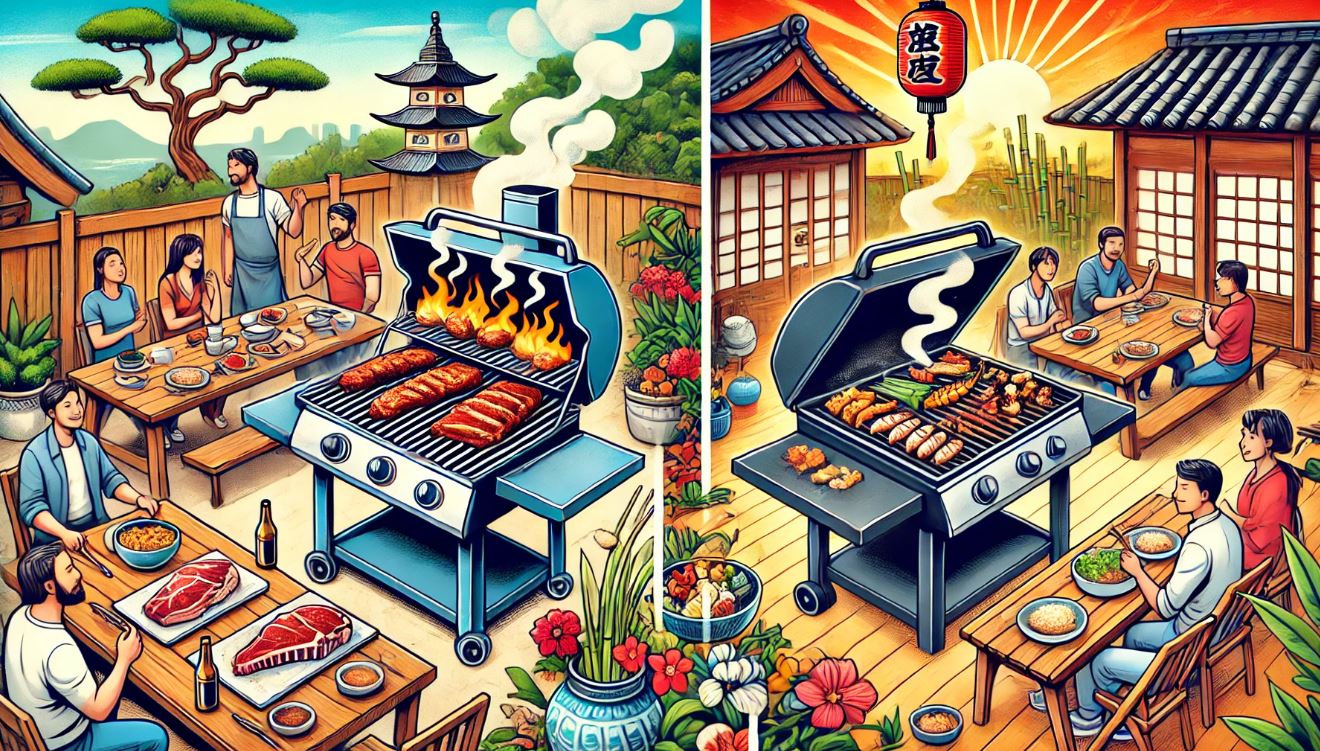What is the difference between BBQ and hibachi? When it comes to grilling, BBQ and hibachi are two popular styles that offer distinct experiences and flavors. Understanding the difference between BBQ and hibachi can help you choose the best method for your culinary adventures. In this guide, we’ll explore the unique aspects of both, from cooking techniques to cultural significance.
Key Takeaways
- BBQ involves slow-cooking meat over indirect heat, often with wood or charcoal, to achieve a smoky flavor.
- Hibachi is a Japanese grilling method that uses direct heat on a flat or open grill, typically fueled by charcoal or gas.
- BBQ is popular in Western cultures, especially in the Southern United States.
- Hibachi is a traditional Japanese cooking style, often associated with teppanyaki in modern settings.
- BBQ emphasizes long cooking times and robust, smoky flavors, while hibachi focuses on quick cooking and subtle, grilled tastes.
BBQ: An In-Depth Look
History and Cultural Significance
BBQ, or barbecue, has deep roots in American culture, particularly in the Southern United States. It originated as a way to cook large cuts of meat slowly over low heat, allowing the flavors to develop fully. This method is often associated with communal gatherings and celebrations.
Cooking Techniques and Equipment
BBQ cooking involves indirect heat, where the meat is placed away from the fire source. This slow-cooking process can take several hours, and the use of wood or charcoal imparts a distinct smoky flavor to the meat. Common BBQ equipment includes:
- Smokers
- Charcoal grills
- Wood-fired grills
Popular BBQ Dishes
- Pulled Pork: Slow-cooked pork shoulder, shredded and often served with a tangy sauce.
- Brisket: A beef cut cooked low and slow until tender.
- Ribs: Pork or beef ribs cooked until the meat falls off the bone.
Hibachi: An In-Depth Look
History and Cultural Significance
Hibachi grilling originated in Japan and is a part of traditional Japanese cuisine. The term “hibachi” refers to a type of small, portable charcoal grill. In modern times, hibachi has become synonymous with teppanyaki, where chefs cook on a large, flat grill in front of diners.
Cooking Techniques and Equipment
Hibachi grilling uses direct heat, with food cooked quickly over an open flame or on a flat grill. This method preserves the natural flavors of the ingredients and often involves minimal seasoning. Key hibachi equipment includes:
- Portable charcoal grills
- Gas-powered flat-top grills
- Traditional hibachi grills
Popular Hibachi Dishes
- Yakiniku: Grilled slices of meat, often served with dipping sauces.
- Teppanyaki Vegetables: A mix of vegetables cooked on a flat grill.
- Grilled Seafood: Fresh seafood like shrimp and scallops, quickly grilled to perfection.
Recent Developments in BBQ and Hibachi
BBQ Trends
- Plant-Based BBQ: Increasing popularity of plant-based meats and vegetarian BBQ options.
- Tech-Enhanced Grilling: Smart grills and smokers with Wi-Fi capabilities for precise temperature control.
Hibachi Trends
- Fusion Cuisine: Combining hibachi techniques with other culinary traditions for unique flavors.
- Sustainable Practices: Emphasis on using sustainable and locally sourced ingredients in hibachi cooking.
Top Experts and Entities in the Field
BBQ Experts
- Aaron Franklin: Renowned pitmaster and owner of Franklin Barbecue in Austin, Texas.
- Myron Mixon: Celebrity chef and multiple-time BBQ competition winner.
Hibachi Experts
- Nobu Matsuhisa: Famous for blending traditional Japanese dishes with Peruvian ingredients.
- Iron Chef Morimoto: Known for his innovative approach to Japanese cuisine, including hibachi.
Conclusion – What is the Difference Between BBQ and Hibachi?
Whether you prefer the slow-cooked, smoky flavors of BBQ or the quick, grilled perfection of hibachi, both methods offer unique and delightful culinary experiences. Understanding the differences between BBQ and hibachi can help you appreciate the art and tradition behind each style.
Internal Links
- What is the Difference Between Club Soda and Sparkling Water?
- What is the Difference Between Brown and White Eggs?
- What is the Difference Between Latte and Cappuccino?
- What is the Difference Between Gelato and Ice Cream?
- What is the Difference Between a Stromboli and a Calzone?
Author
This article was written by HowDiff, experts in writing comparison articles across a variety of topics.
